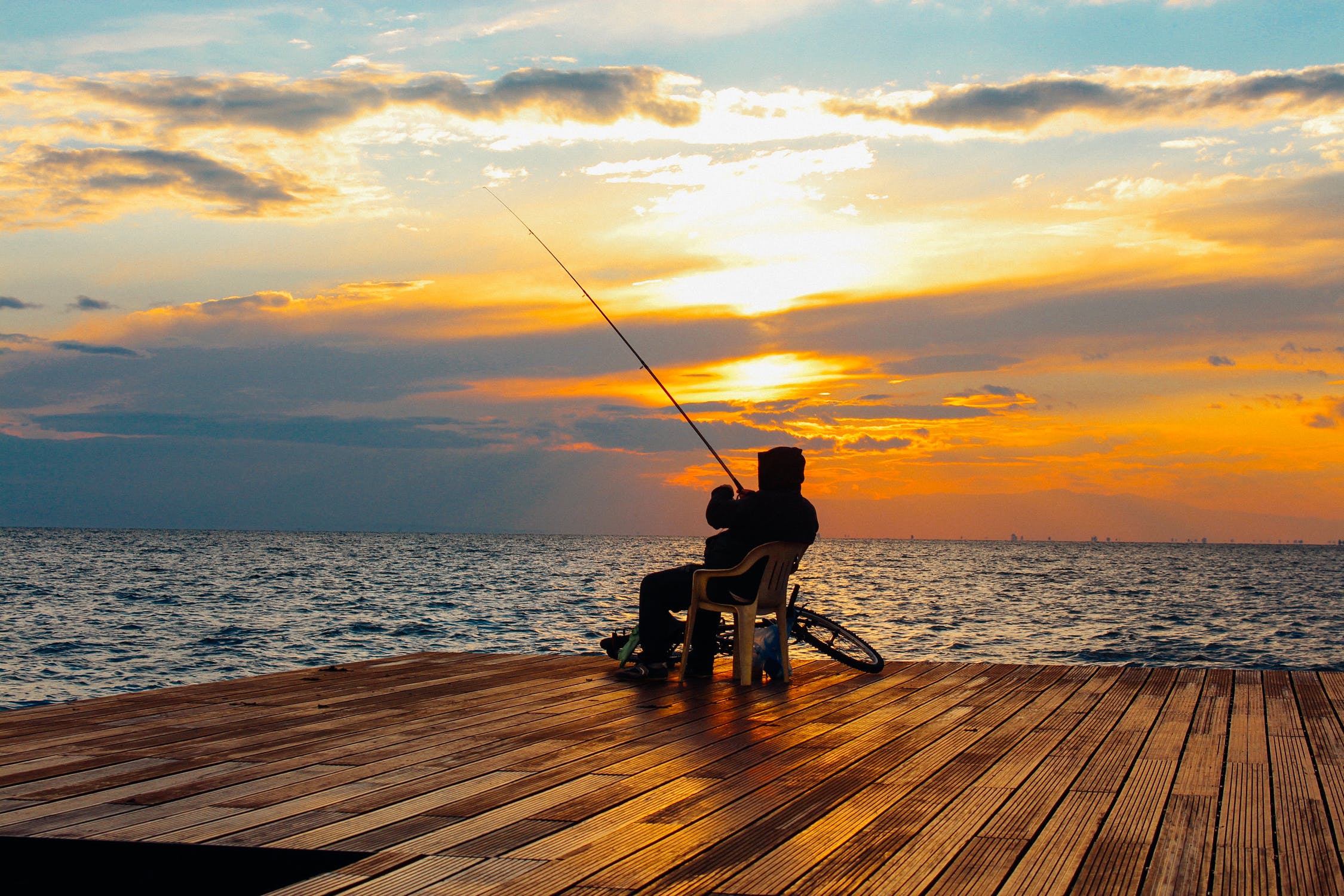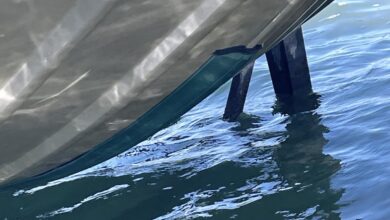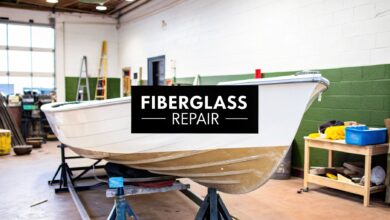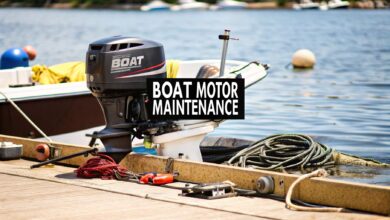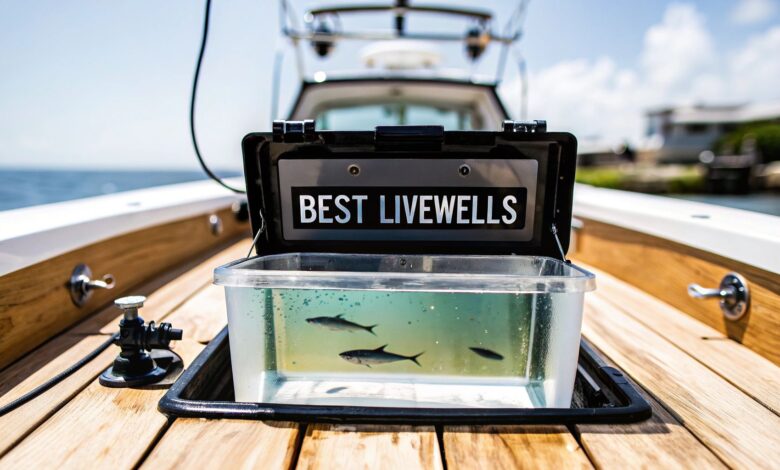
A good livewell isn't just a bucket to toss your fish in. It's a sophisticated life-support system that can make or break your day on the water. The best livewell tanks for boats create a stable, healthy environment with fresh, oxygenated water.
Why Your Livewell Is Your Most Crucial Fishing Tool
A thoughtfully designed livewell does more than simply hold your catch. It preserves the fish's health from hookset to release. This is critical for tournament anglers or anyone serious about catch-and-release.
At its heart, every effective livewell boils down to a few essentials.
- Durable Construction: It must be built with materials that can handle sun, salt, and general abuse.
- Sufficient Capacity: The tank needs to be the right size and shape for the fish you're chasing.
- Powerful Aeration: A solid system is needed to keep oxygen levels just right.
These elements are the foundation for a stable environment for your catch. Livewell technology is a major focus for boat manufacturers. The recreational fishing industry contributed around $208 billion to the U.S. economy in 2020.
Think of your livewell as a mobile, high-performance aquarium. The goal is to mimic the fish's natural habitat to minimize shock and keep it healthy.
While a livewell is for your catch, the science is identical to keeping bait alive. Understanding how to pick the right system is fundamental for any angler. If you want to dive deeper, check out our guide on how to choose a bait tank for your boat.
Polyethylene vs. Fiberglass Livewell Tanks
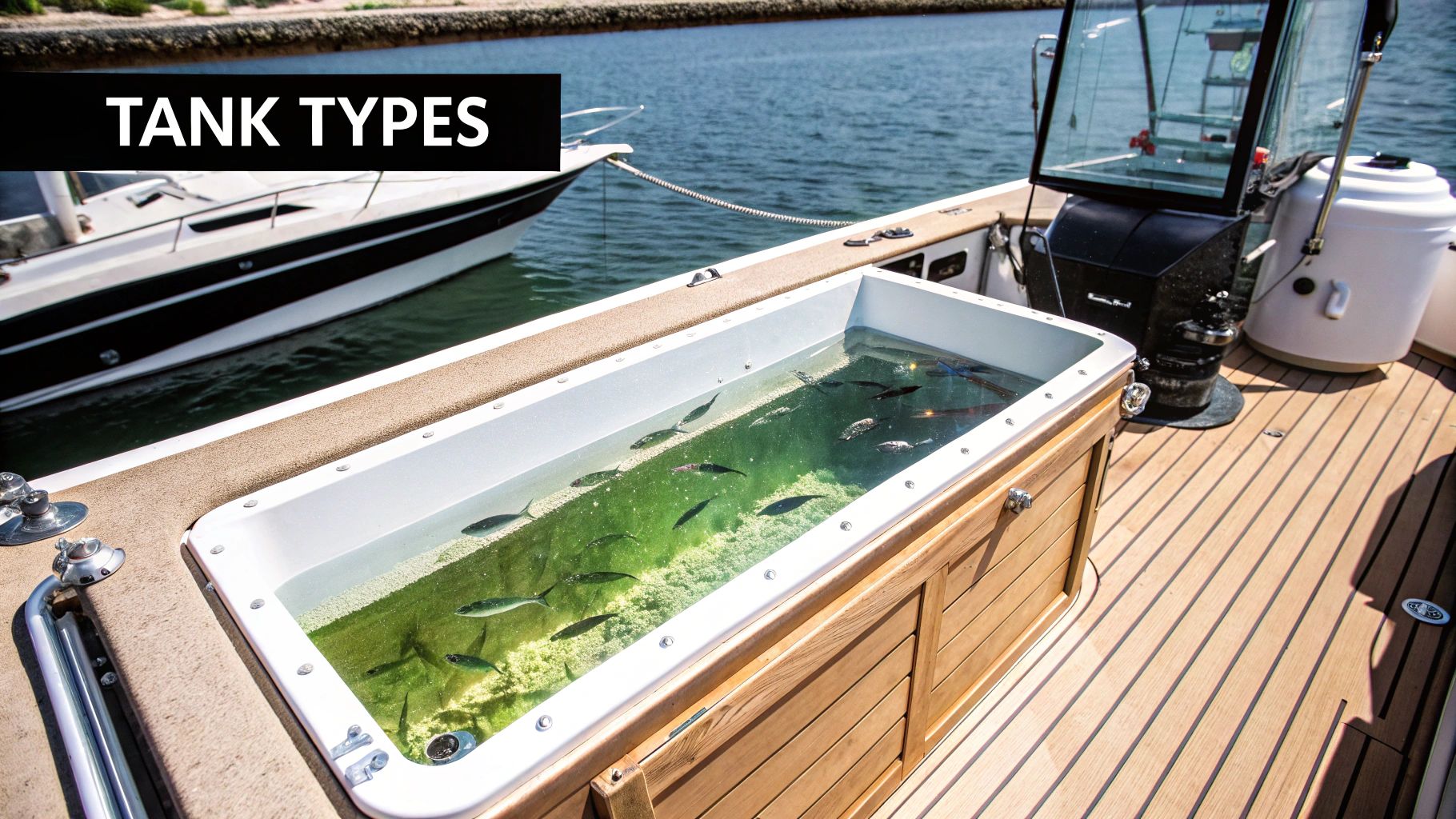
When outfitting a boat with a livewell, your first big decision is the material. It boils down to two main contenders: polyethylene and fiberglass. This choice influences durability, installation, and cleaning.
Polyethylene is a tough plastic known for its incredible impact resistance. These tanks are usually rotationally molded, meaning they're formed in one solid piece without seams. This process gives them a consistent wall thickness and makes them immune to cracking.
A drop-in polyethylene tank is a fantastic option for smaller boats or simple setups. They are lightweight, affordable, and easy to install. Plus, their smooth, non-porous surface is a breeze to clean.
Material Durability and Integration
Fiberglass tanks are a different breed. They bring rigidity and a high-end, custom-fit finish. Most of the time, these are molded directly into the deck or hull as a seamless part of the boat.
While fiberglass is strong, it doesn't have the "give" of polyethylene. It can develop spider cracks if it takes a hard knock. On the upside, fiberglass handles sun exposure better and can be gel-coated to match your boat's color.
The choice is often integration versus portability. A custom fiberglass tank looks factory-installed, while a polyethylene tank is a rugged, practical solution.
You can't go wrong with either material. Polyethylene is the champ for durability and value. Fiberglass, however, is the clear winner for custom, fully integrated systems.
Understanding Aeration and Pumping Systems
A livewell tank is just a box until you add the components that keep fish healthy. The pump and aerator are the heart and lungs of your setup. They work together to keep the water fresh and oxygenated.
The pump handles circulation, measured in gallons per hour (GPH). A pump that's too weak won't exchange water fast enough. A pump that's too powerful will turn the tank into a whirlpool, stressing the fish.
Aeration dissolves oxygen into the water for the fish to breathe. This can be a simple spray bar or a sophisticated infusion system. The right method depends on your target species and how many fish you hold.
Optimizing for Fish Health
The goal is to create a stable, low-stress environment. A good system doesn't just keep fish alive; it keeps them strong. Anglers wanted easier access, so manufacturers responded with smarter designs.
You can find excellent examples of modern integrated livewell systems that show this progress.
Choosing an aeration system isn't just about keeping fish alive; it's about keeping them in prime condition. Proper oxygenation reduces lactic acid buildup in the fish's muscles.
To understand the difference a quality livewell makes, look at the data. The numbers on survival rates and oxygen levels speak for themselves.
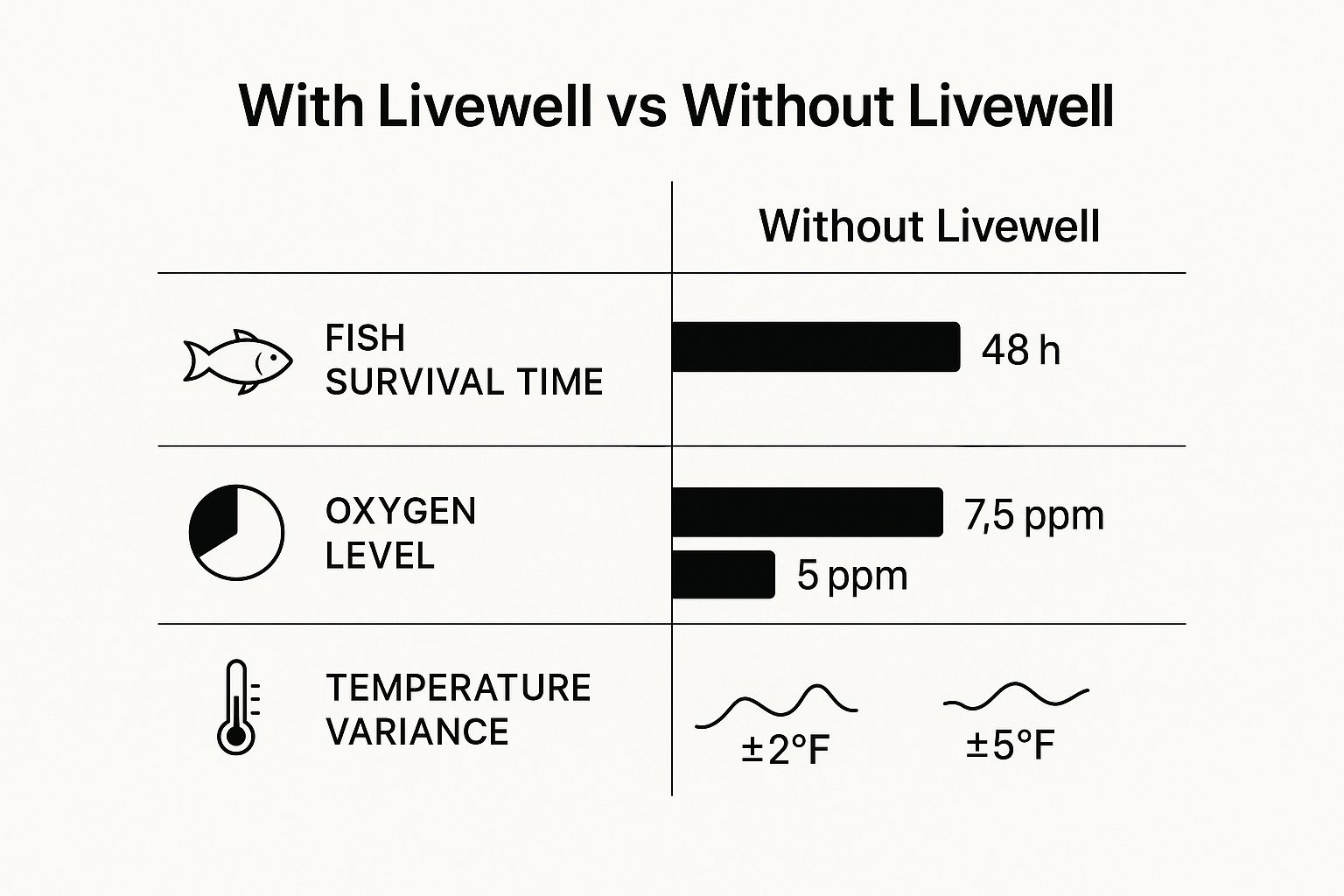
As you can see, a properly aerated livewell can more than double a fish's survival time. It also maintains much more stable water conditions. This is a huge advantage on the water.
Every livewell needs a few core components to function properly. Understanding each part helps you diagnose problems or plan a custom setup.
Aeration System Feature Comparison
| Component | Function | Ideal Use Case | Key Consideration |
|---|---|---|---|
| Aerator Pump | Draws water into the livewell and powers the spray head. | The workhorse for nearly every livewell system, from basic to complex. | Match the GPH rating to your tank volume for optimal circulation. |
| Spray Head | Agitates the water surface to introduce oxygen. | Simple, effective for most freshwater and inshore applications. | Placement matters—aim for maximum surface disruption without creating a firehose effect. |
| Venturi Aerator | Uses water pressure to draw in air and create fine bubbles. | Excellent for increasing dissolved oxygen in crowded bait tanks. | Requires adequate pump pressure to work efficiently; may clog in debris-filled water. |
| Air Stone / Bubbler | Releases a steady stream of bubbles from an air pump. | A great secondary system for very large tanks or delicate species. | The air pump is a separate component and requires its own power source. |
These components are the building blocks of any effective system. By combining them thoughtfully, you can create a livewell that keeps your catch ready for weigh-in.
Selecting the Right Tank Size and Shape
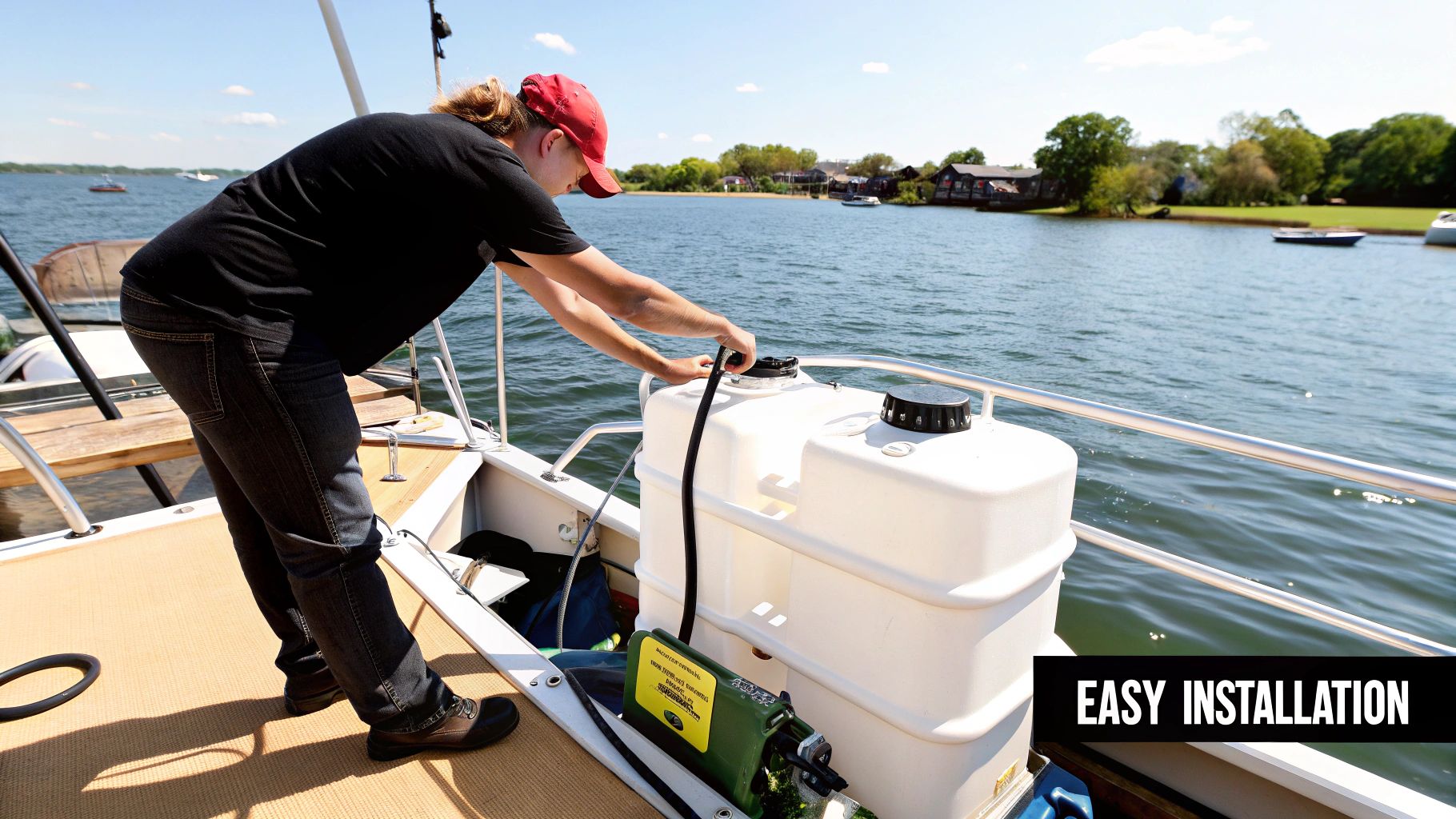
Picking the right livewell isn't as simple as getting the biggest one you can fit. The one pound of fish per gallon rule is just a starting point. Consider what you fish for, how long you're out, and the water temperature.
Overstuffing your livewell is a surefire way to stress your catch. Be realistic about your needs. A compact tank makes sense for inshore anglers, while offshore tournament anglers need a much bigger setup.
Optimizing Shape for Fish Safety
The shape of livewell tanks for boats is as critical as its size. Oval and round tanks are hands-down the best choice over rectangular ones. They prevent fish from bumping their noses into sharp corners.
This constant bumping is a major source of stress and can cause physical damage.
A rounded interior helps the aeration system create a gentle, circular current. This eliminates "dead spots" where oxygen-poor water can settle. The result is a calmer, healthier environment for your fish.
Thinking through these details separates a well-rigged boat from an average one. It's like knowing how to properly secure your vessel. You can learn more about choosing the best dock lines in another guide.
The leisure boat market is projected to hit $87.53 billion by 2034. It’s clear that more boaters are investing in getting their setups just right. Discover more insights about the leisure boat market at Market.us.
Proper Installation and Maintenance
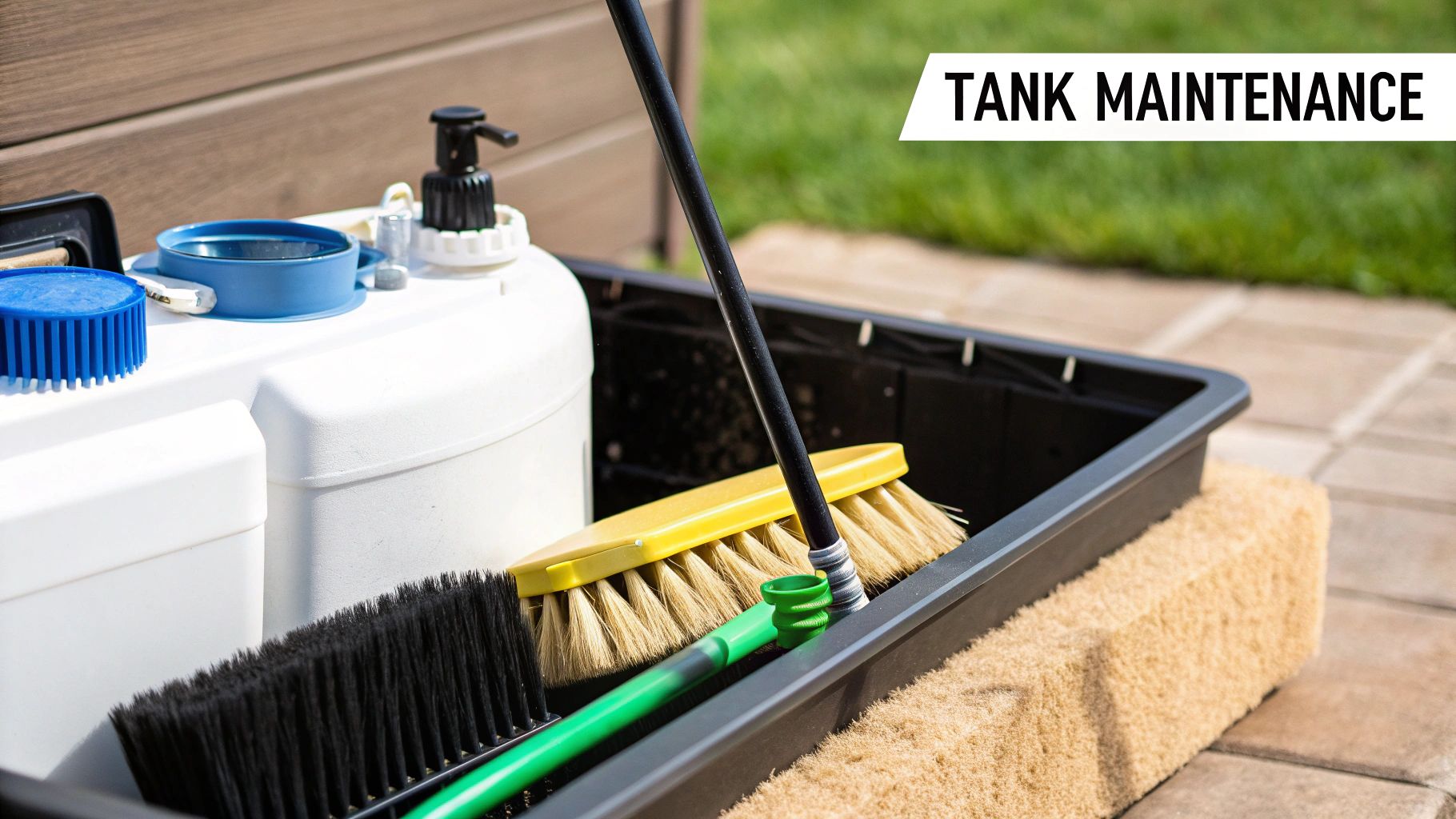
A great livewell system installed poorly won't do you any good. Getting the installation right from the start is essential. First, nail down the location, considering how a full tank's weight will affect your boat’s trim.
Once you’ve picked a spot, focus on the plumbing. Every connection, especially the intake seacock and overflow drain, needs to be double-clamped and sealed. A leak below the waterline is dangerous, not just an inconvenience.
For the electrical side, use marine-grade tinned wire and heat-shrink connectors to fight corrosion. Your system must run on a dedicated, fused circuit. This ensures reliable power and prevents a potential fire hazard.
Routine Checks and Troubleshooting
Great livewell tanks for boats need consistent upkeep to perform their best. After every outing, you must clean, drain, and dry the entire system. This quick habit prevents mold and stops the spread of invasive species.
A common point of failure is a clogged pump or aerator head. Debris like seaweed or bait scales can easily block the intake. Regularly inspect and clear these components to ensure consistent flow.
Think of your livewell like any other critical system on your boat. Just as you perform routine boat motor maintenance, check all livewell hoses for wear. Catching a small problem at the dock is better than a major failure on the water.
When things go wrong, a little know-how can save the day. Most livewell issues are straightforward to diagnose if you know what to look for.
Livewell System Troubleshooting Guide
| Symptom | Potential Cause | Solution |
|---|---|---|
| Pump runs, but no water flows | Clogged intake or airlock in the system | Clear debris from the intake screen. To fix an airlock, cycle the pump on and off, or back the boat up to force water into the intake. |
| Weak water flow | Partially clogged intake, failing pump impeller, or low battery voltage | Inspect and clean the intake. Check the impeller for wear and replace if needed. Test your battery voltage. |
| Pump won't turn on | Blown fuse, loose wiring, or a dead pump motor | Check the fuse/breaker. Inspect all electrical connections for tightness and corrosion. Test the motor. |
| Tank drains too quickly | Leaky drain plug, cracked hose, or a loose fitting | Inspect the drain plug seal and replace if worn. Check all hoses and clamp connections for leaks. |
This quick guide covers the most frequent headaches. By staying on top of maintenance and knowing how to troubleshoot, you’ll keep your livewell in top shape.
Your Livewell Tank Questions, Answered
How Often Should I Run My Livewell Pump?
Ideally, your pump should run continuously when fish are in the tank. Constant circulation is the best way to keep the water fresh and oxygenated.
If you're worried about draining your battery, you can cycle the pump. A good starting point is running it for 5-10 minutes every 30 minutes. Factors like water temperature and catch size will influence the ideal cycle.
Can I Use One Livewell for Both Bait and Catch?
You can, but it’s not ideal. Separate livewell tanks for boats is the preferred choice. This avoids overcrowding and reduces stress on your catch.
If you have a single tank, a divider is a must-have. This will keep your prized catch from eating your bait. Also, ensure your aeration system can handle the increased load.
What's the Ideal Water Temperature for a Livewell?
The key is consistency. Your goal is to match the livewell water temperature to the water you're fishing in. A sudden temperature shock is one of the biggest stressors for a fish.
On a hot day, the water in your tank can heat up. You can cool it by adding a frozen water bottle or two. Do it gradually to avoid a drastic temperature drop.
At Boating Articles, we're here to share real-world advice to help you get the most out of your time on the water. For more in-depth guides and tips, visit us at https://boating-articles.com.
